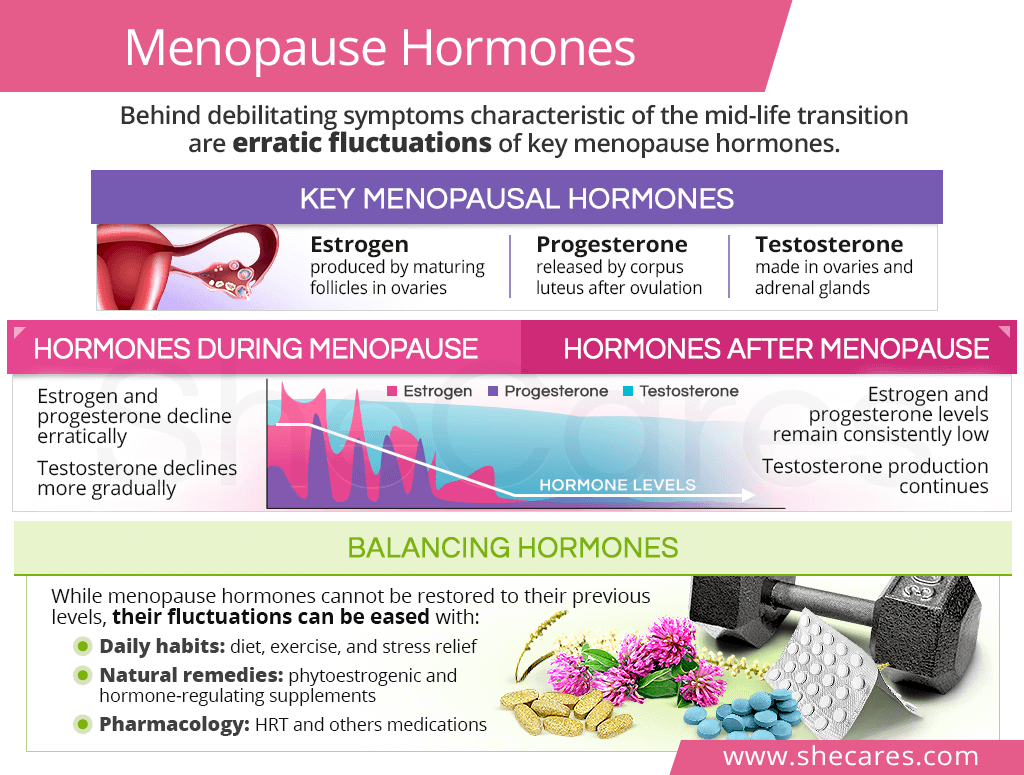What are Key Menopause Hormones?

Menopause hormones are not a distinct set of hormones specific to menopause. The same hormones guide a woman's menstrual cycles since puberty. What is different, however, is their levels during this life stage.
There are three, most important menopause hormones behind mid-life changes, each with its own set of functions:
Estrogen. It is produced in the ovaries by the follicles that house the eggs. Estrogen is what gives women their feminine characteristics and reproductive abilities. It is also key for heart health, bone density, mood, and more.
Progesterone. It is produced by empty follicles (a structure called the corpus luteum) after egg release on ovulation. On a monthly basis, it prepares the body for pregnancy if conception takes place.
Testosterone. It is made by the adrenal glands and ovaries in much smaller amounts than in men. It plays a role in estrogen production as well as women's libido, bone health, muscle development, and more.
Keep in mind that the functioning of these key menopause hormones would not be possible without an array of other hormones, such as gonadotropin-releasing hormone, luteinizing hormone, and follicle-stimulating hormone, among others.
What Happens to Hormones during Menopause?

Essentially, the menopausal transition is the erratic decline of key menopause hormones, starting with perimenopause and ending at postmenopause.
Decline of Estrogen and Progesterone
Mid-life hormonal drops start when the ovaries - the main estrogen and progesterone producers - begin running out of eggs. The number of eggs, called ovarian reserve, is set at birth and decreases at various speeds throughout a woman's life.
After 35, however, that decline becomes faster and reaches total depletion by the age of 51, on average.1 This is when a woman will stop having monthly periods and will lose the ability to get pregnant.
With a depleting ovarian reserve, estrogen and progesterone production will decline unpredictably and, eventually, halt. Low estrogen levels trigger hot flashes and vaginal dryness, while low progesterone in perimenopause causes irregular periods.
Decline of Testosterone
During menopause, testosterone levels are not as affected as those of estrogen and progesterone. In fact, slow testosterone decline is said to be more related to age, than to menopause itself.
By the menopausal date, women will have about half of the testosterone they had in their 20s.2 However, science is unclear about the symptoms declining testosterone may have on a woman's menopausal health.
What Happens to Menopausal Hormones after Menopause?

Once a woman had missed her periods for 12 consecutive months, she is said to have entered postmenopause.3 During this life stage, there are no drastic hormonal fluctuations, and hormone levels remain consistently low.
Although ovaries no longer produce estrogen and progesterone, small amounts of both hormones are maintained through the conversion of testosterone in the adrenal glands and body fat tissues. The ovaries will, however, continue making testosterone after menopause.
It is worth mentioning that low hormone levels put women at an increased risk for certain menopause problems, including heart disease, incontinence, and osteoporosis.
How to Balance Hormones during Menopause

While no strategy will restore menopausal hormones to their previous levels, various approaches can lessen their fluctuations, thus alleviating many discomforts their imbalance caused.
From the most to the least natural options, balancing hormones and relieving menopause symptoms may involve the following:
Daily habits. Improving their lifestyle is usually the first thing women do when struggling with transitional symptoms. This may include following a menopause diet, optimizing their mid-life workout routines, relieving stress, and more.
Natural remedies. A number of herbs for menopause can help balance hormones and bring short- or long-term relief, including phytoestrogenic supplements, such as black cohosh, and hormone-regulating supplements, like Macafem.
Pharmacology. When faced with severe symptoms, women may consider menopause medications, such as hormone replacement therapy (HRT), which can relieve symptoms quite effectively, but may involve serious side effects.
Key Takeaways
Behind the debilitating symptoms of mid-life transition are erratic fluctuations of key menopause hormones, mainly estrogen and progesterone. They begin around women's 40s when their ovaries start running out of egg-containing follicles, which are the main producers of said hormones. Roughly by the age of 51, ovarian reserve of the eggs is depleted, halting estrogen and progesterone production. Testosterone levels, on the other hand, also decrease throughout a woman's life, but their decline is more related to aging versus menopausal changes. The hormone's production by the ovaries will, therefore, continue in postmenopause, with some of the hormone being converted into estrogen and progesterone. Luckily, women can balance their hormone levels and allay symptoms with various treatments, like daily habits, herbal remedies, and medications.
Sources
- American Society for Reproductive Medicine. (2015). Menopausal Transition (Perimenopause): What Is It? Retrieved January 25, 2021 from https://www.reproductivefacts.org/news-and-publications/patient-fact-sheets-and-booklets/documents/fact-sheets-and-info-booklets/the-menopausal-transition-perimenopause-what-is-it/
- Australasian Menopause Society. (n.d.). Testosterone and Women. Retrieved January 25, 2021 from https://www.menopause.org.au/health-info/resources/1484-testosterone-and-women
- Cleveland Clinic. (2019). Menopause, Perimenopause, and Postmenopause. Retrieved January 25, 2021 from https://my.clevelandclinic.org/health/diseases/15224-menopause-perimenopause-and-postmenopause
- Endocrine Society. (n.d.). Menopause. Retrieved January 25, 2021 from https://www.hormone.org/diseases-and-conditions/menopause
- Harvard Health Publishing. (2020). Perimenopause: Rocky road to menopause. Retrieved January 25, 2021 from https://www.health.harvard.edu/womens-health/perimenopause-rocky-road-to-menopause
- NHS. (2018). Menopause. Retrieved January 25, 2021 from https://www.nhs.uk/conditions/menopause/
- Society for Endocrinology. (2019). Menopause. Retrieved January 25, 2021 from https://www.yourhormones.info/endocrine-conditions/menopause/
- Women's Health Concern. (2019). The Menopause. Retrieved January 25, 2021 from https://www.womens-health-concern.org/help-and-advice/factsheets/menopause/
Footnotes:
- National Center for Complementary and Integrative Health. (2017). Menopausal Symptoms: In Depth. Retrieved January 25, 2021 from https://www.nccih.nih.gov/health/menopausal-symptoms-in-depth
- The North American Menopause Society. (n.d.). Changes in Hormones Levels. Retrieved January 25, 2021 from https://www.menopause.org/for-women/sexual-health-menopause-online/changes-at-midlife/changes-in-hormone-levels
- The North American Menopause Society. (n.d.). How Do I Know I'm in Menopause? Retrieved January 25, 2021 from https://www.menopause.org/for-women/menopauseflashes/menopause-symptoms-and-treatments/how-do-i-know-i%27m-in-menopause-
